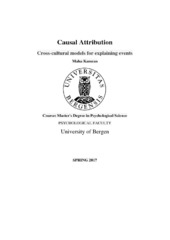Causal Attribution. Cross-cultural models for explaining events
Master thesis
Permanent lenke
https://hdl.handle.net/1956/15968Utgivelsesdato
2017-06-13Metadata
Vis full innførselSamlinger
Sammendrag
The purpose of this study was to examine and compare the association between culture and causal attribution for Saami and Norwegian participants. Data was collected through cognitive mapping, a technique aimed towards the investigation of causal attribution. Cognitive mapping investigates the causal models people hold, and sheds light on content, factors, structure, causal categories and maps people construct when forming explanations for events and situations. The events constructed in this study were based on Physical-, Biological-, Social and Psychological-, Supernatural- and Composite domain knowledge. Testing the causal model involved the three steps: 1) free listing of causal entities, 2)construction of causal maps and 3) identification of important factors in the maps for a selection of events across domains. There were 38 respondents, constituting of Saami (N = 19) and Norwegian (N = 19) participants. They were presented with the exact same events but in random order. The following cases were investigated: most different individual factors across domains, most different key factors, factor distribution within and across domain, factors within and across causal categories, differences and similarities in causal maps. Differences found related to individual- and key factor difference, use of more unidirectional arrows for the Saami and bidirectional arrows for the Norwegian. There was no significant difference between the groups in the scope of causal distribution across and within domain, causal categories and causal maps. The results were interpreted in terms of the relationship between the groups and the individual position within that group, as well as mechanisms of thinking and reasoning. Formålet med dette studiet var å undersøke og sammenligne sammenhengen mellom kultur og de kausale modellene tilhørende samiske og norske deltakere. Informasjonen ble samlet inn og behandlet i gjennom kognitiv kartlegging, en metode som har som mål å belyse årsakssammenhenger. Kognitiv kartlegging undersøker de kausale modellene folk holder, og fremhever forskjeller og likheter ved innhold, faktorer, struktur, kausale kategorier og kausale kart, som folk konstruerer når de produserer forklaringer basert på hendelsesforløp. Hendelsene som ble konstruert i dette studien var basert på fysisk, biologisk, Sosial og Psykologisk, overnaturlige og sammensatt domenekunnskap. De kausale modellene ble testet gjennom tre trinn: 1) Fri assosiasjon vedrørende årsakssammenhenger, 2) Konstruksjon av kausalt kart og 3) Identifikasjon av nøkkelfaktorer i kartene. Av 38 respondenter, var halvparten samiske (N = 19) og halvparten nordmenn (N = 19). Deltakerne ble presentert med nøyaktig samme hendelser, men i tilfeldig rekkefølge. Resultatene som ble presentert i denne studien var: mest forskjellige individuelle faktorer, mest forskjellige nøkkelfaktorer, distribusjonen av faktorer på tvers av og internt i domenet, distribusjon av faktorer på internt i kausale kategorier, forskjeller og likheter ved kausale kart. Forskjellene som ble funnet var knyttet til forskjeller i blant individuelle faktorer og i blant nøkkelfaktorer, bruk av mer enveis piler for samiske deltakere og toveis piler for norske deltakere. Det var ingen signifikant forskjell mellom gruppene i omfanget av årsaksfordeling på tvers av og innenfor domenet, de kausale kategoriene og de kausale kartene. Resultatene ble tolket i forhold til posisjonen og forholdet mellom individ og gruppe, samt mekanismer for tenkning og resonnement.
